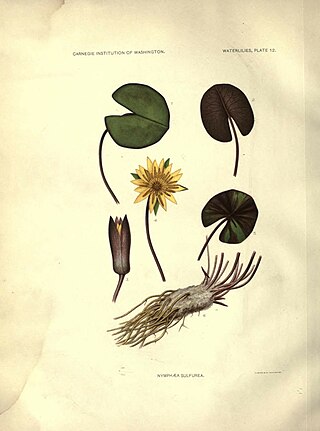Top Qs
Timeline
Chat
Perspective
Nymphaea sulphurea
Species of water lily From Wikipedia, the free encyclopedia
Remove ads
Nymphaea sulphurea is a species of waterlily native to Angola, Zambia, and the Democratic Republic of the Congo.[2]
Remove ads
Description
Vegetative characteristics
Nymphaea sulphurea has stout, cone-shaped rhizomes. The suborbicular to broadly ovate, petiolate,[3] 4.5-5.5 cm long leaves[4] have an entire margin. The petioles are 38–46 cm long.[3]
Generative characteristics
The flowers are 4.5–7 cm wide. The lanceolate sepals with acute apex[3] are 2–3 cm long, and 1.5–1 cm wide. The dark sulphur yellow petals are 2.8–2 cm long, and 1.2-0.7 cm wide.[4] The androecium consists of 40-50 stamens with bright yellow anthers. The gynoecium consists of 12-14 carpels.[3]
Remove ads
Taxonomy
Publication
It was first described by Ernest Friedrich Gilg in 1903.[2]
Type specimen
The type specimen was collected by Hugo Baum in Minnesera on 17 January 1900.[3]
Etymology
The specific epithet sulphurea, from the Latin sulphureus, means yellow,[5][6] and refers to the floral colouration.
Conservation
Ecology
Habitat
Nymphaea sulphurea occurs in rivers, lakes, pools, and in deep waters.[1]
References
Wikiwand - on
Seamless Wikipedia browsing. On steroids.
Remove ads


